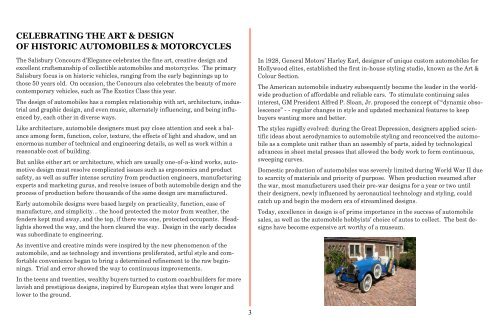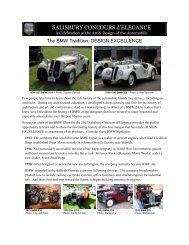The 2011 Salisbury Concours d'Elegance
The 2011 Salisbury Concours d'Elegance
The 2011 Salisbury Concours d'Elegance
Create successful ePaper yourself
Turn your PDF publications into a flip-book with our unique Google optimized e-Paper software.
CELEBRATING THE ART & DESIGN<br />
OF HISTORIC AUTOMOBILES & MOTORCYCLES<br />
<strong>The</strong> <strong>Salisbury</strong> <strong>Concours</strong> d’Elegance celebrates the fine art, creative design and<br />
excellent craftsmanship of collectible automobiles and motorcycles. <strong>The</strong> primary<br />
<strong>Salisbury</strong> focus is on historic vehicles, ranging from the early beginnings up to<br />
those 50 years old. On occasion, the <strong>Concours</strong> also celebrates the beauty of more<br />
contemporary vehicles, such as <strong>The</strong> Exotics Class this year.<br />
<strong>The</strong> design of automobiles has a complex relationship with art, architecture, industrial<br />
and graphic design, and even music, alternately influencing, and being influenced<br />
by, each other in diverse ways.<br />
Like architecture, automobile designers must pay close attention and seek a balance<br />
among form, function, color, texture, the effects of light and shadow, and an<br />
enormous number of technical and engineering details, as well as work within a<br />
reasonable cost of building.<br />
But unlike either art or architecture, which are usually one-of-a-kind works, automotive<br />
design must resolve complicated issues such as ergonomics and product<br />
safety, as well as suffer intense scrutiny from production engineers, manufacturing<br />
experts and marketing gurus, and resolve issues of both automobile design and the<br />
process of production before thousands of the same design are manufactured.<br />
Early automobile designs were based largely on practicality, function, ease of<br />
manufacture, and simplicity… the hood protected the motor from weather, the<br />
fenders kept mud away, and the top, if there was one, protected occupants. Headlights<br />
showed the way, and the horn cleared the way. Design in the early decades<br />
was subordinate to engineering.<br />
As inventive and creative minds were inspired by the new phenomenon of the<br />
automobile, and as technology and inventions proliferated, artful style and comfortable<br />
convenience began to bring a determined refinement to the raw beginnings.<br />
Trial and error showed the way to continuous improvements.<br />
In the teens and twenties, wealthy buyers turned to custom coachbuilders for more<br />
lavish and prestigious designs, inspired by European styles that were longer and<br />
lower to the ground.<br />
3<br />
In 1928, General Motors’ Harley Earl, designer of unique custom automobiles for<br />
Hollywood elites, established the first in-house styling studio, known as the Art &<br />
Colour Section.<br />
<strong>The</strong> American automobile industry subsequently became the leader in the worldwide<br />
production of affordable and reliable cars. To stimulate continuing sales<br />
interest, GM President Alfred P. Sloan, Jr. proposed the concept of “dynamic obsolescence”<br />
- - regular changes in style and updated mechanical features to keep<br />
buyers wanting more and better.<br />
<strong>The</strong> styles rapidly evolved: during the Great Depression, designers applied scientific<br />
ideas about aerodynamics to automobile styling and reconceived the automobile<br />
as a complete unit rather than an assembly of parts, aided by technological<br />
advances in sheet metal presses that allowed the body work to form continuous,<br />
sweeping curves.<br />
Domestic production of automobiles was severely limited during World War II due<br />
to scarcity of materials and priority of purpose. When production resumed after<br />
the war, most manufacturers used their pre-war designs for a year or two until<br />
their designers, newly influenced by aeronautical technology and styling, could<br />
catch up and begin the modern era of streamlined designs.<br />
Today, excellence in design is of prime importance in the success of automobile<br />
sales, as well as the automobile hobbyists’ choice of autos to collect. <strong>The</strong> best designs<br />
have become expensive art worthy of a museum.




